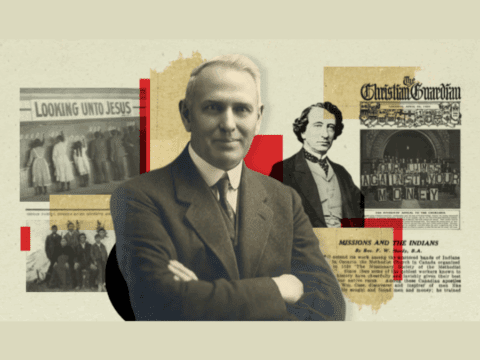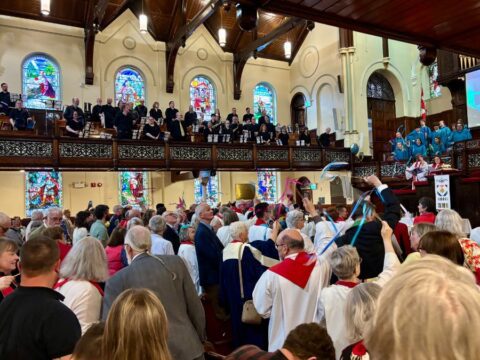Zion United, near Mitchell’s Corners, Ont., once sat in open countryside. These days you can see the suburban subdivisions of nearby Courtice, Ont., from the church’s second-storey windows.
The small rural congregation, located about 40 km east of Toronto, is holding on to its friendly, family-oriented traditions but also reaching out to new neighbours. “There’s energy and excitement, and the congregation wants to do new things,” says Zion’s minister, Rev. Deb Foster. Recent outreach innovations have included an evening with a recovered alcoholic, a night of environmental films and a blue Christmas worship service. Future events include discussions on depression and training in cardio-pulmonary resuscitation.
Rural congregations like Zion make up more than half of the United Church’s preaching places. And many of them are changing because the very fabric of rural Canada is changing, too. Rural areas that saw their populations shrink for decades as family farms declined are now a magnet for retirees and urban commuters. Rural economies are beginning to diversify as service- and knowledge-based industries migrate from the cities. Congregations that find ways to adapt to these changes are thriving and developing new ministries. Those that don’t will likely die.
Some have already fallen by the wayside. Recent church statistics show 14.6 percent fewer rural congregations in the last decade, compared to a loss of 12 percent of all congregations. Membership in rural churches is dropping too, part of an overall decline in church membership that began in the late 1970s.
But there are also many examples of rural churches on the rebound. Almost without exception, those finding new opportunities in changing circumstances follow the cardinal rule of congregational rebirth everywhere: know thy community. “God’s out there whether we are involved or not,” says Rev. Harry Oussoren, the General Council official in charge of congregational ministries. “If people are not aware of their context, they are missing out on what God is doing.” Congregations intent on simply “hanging on” won’t last. “If you’re looking inward at survival and maintenance then there’s not much purpose there.”
Often, the process of adapting begins with challenging conventional wisdom that has prevailed for decades. Like countless small communities on the Prairies, the southwest Saskatchewan town of Abbey struggled for years with the crisis in agriculture and the perception that it was doomed. Then retirees from British Columbia began to look for places where their real estate dollars might go further and resource companies began to probe the landscape for new sources of natural gas. The net effect was an influx of new people — and a chance for area churches to reinvent themselves.
“A lot of people are moving in, and we need to be open to them,” says Rev. Catherine Christie of the Abbey-Lancer-Portreeve (Sask.) pastoral charge. Transforming itself from “the last institution the community can trust” into a renewed community focal point with open doors and an open mind is “a continuing challenge,” she says.
The newcomers don’t always attend worship regularly, but fundraisers and other church events that generate a lot of support are encouraging signs of the church’s rising profile in the community, says Christie.
The more churches get involved in their changing communities, the more likely communities will eventually get involved in the church. That’s true not just on the Prairies but just about everywhere else in rural Canada.
In Quebec’s Eastern Townships, the English-speaking population is declining and francophones are moving in. Traditionally, the Danville-Asbestos (Que.) charge has been an anglophone congregation. But recently it began attracting francophones and now offers worship, wedding and funeral services in Quebec’s official language. And members are becoming more active in area business and community development groups.
“That’s the way to walk with people,” says Lou Joyal, a member of nearby South Durham (Que.) United who helps provide French-language services and worship in several area churches. “If you are not part of the community, how do you make contact? If you just stay with the old stuff, you will never grow,” she says.
That seems self-evident, and to many congregations it is. But sometimes resistance to change is a very real hurdle and occasionally it’s best to proceed with caution and compassion. Marvin Anderson, the General Council’s former rural ministry staff person, has taught and written extensively on rural ministry. He says rural people sometimes “feel they are being overtaken” by outsiders. Rural hospitality, he says, has “written and unwritten rules,” and “people who are strangers don’t just come in and take over.”
Protecting tradition and resisting change is a natural reaction to any threatened takeover, Anderson continues. It’s also important to understand the historical place of the church in rural communities. “The rural church holds such strong feelings for people because it is so often the last bastion of rural culture and identity.”
Anticipating change and allowing new visions to evolve naturally is key to striking a happy balance between old and new. Oussoren says the process can be as simple as congregations “going to their neighbours — governments, non-profits, businesses, residents or industries — and asking, ‘Would you give a darn if the United Church wasn’t here?’” Their answers can lead the way to a new sense of purpose.
The congregation at the Dalston-Crown Hill pastoral charge just north of sprawling Barrie, Ont., could see change on the horizon and decided that clinging to “the church’s romantic history” was less important than offering a place for everyone to feel they belong, says Rev. George Moore. They have begun laying the groundwork for an anticipated influx of newcomers with an increased emphasis on outreach, interfaith education and upbeat music and worship, as well as a new mission statement — “growing spiritually while celebrating diversity” — that proclaims their doors are open.
Once open, those doors can lead to remarkable transformations. For one thing, longtime congregation members find they don’t have to shoulder as many volunteer duties as they once did when newcomers arrive with fresh energy and ideas. Heritage United in Washago, Ont., has seen an influx of retirees in the past decade, and original members are “delighted that those new people are taking responsibilities,” says Rev. Toni Birtch. “They don’t feel threatened at all.”
More significantly, perhaps, the blending of urban and rural that characterizes so many rural churches in transition can broaden spiritual perspectives and renew vigour for the Christian faith itself. The Town of Caledon, northwest of Toronto, used to be a quiet refuge of rolling hills, country retreats and lovingly manicured horse farms. In the last decade, the population has soared by 43 percent, and the countryside has become dotted with estate-style housing and new subdivisions with large young families.
Rev. Shelley Roberts of Palgrave (Ont.) United credits longtime members with being “exceedingly hospitable and very open” — so open, in fact, that traditional mid-week groups have given way to programs with a decidedly urban touch, such as reiki and yoga classes. Roberts says, “really good lay people,” many of them new to church as well as the area, hold the congregation together and help it to grow.
And “they’re much better evangelists” than many longtime United Church people, she says. “They’re willing to stand up in church and share their faith stories and also talk about it with their co-workers and people outside the church.”
In the broad sweep of rural churches in transition, Palgrave United — in a village that’s been swallowed up by Caledon’s sprawl — is likely the exception. It has transformed to the point where you might argue that it’s no longer a rural church, that it needs to be called something else, maybe ex-urban. Zion United in Mitchell’s Corners is more likely the rule — still in the countryside with a traditionally rural membership, but watching change creep closer and extending a hand of welcome.
“We’re trying to build bridges and carry out ministry in the community, to break down barriers like Jesus did,” says Deb Foster. “We’re taking little steps.”
***
This story first appeared in The United Church Observer’s March 2008 issue with the title “Rural churches at a crossroads.”














